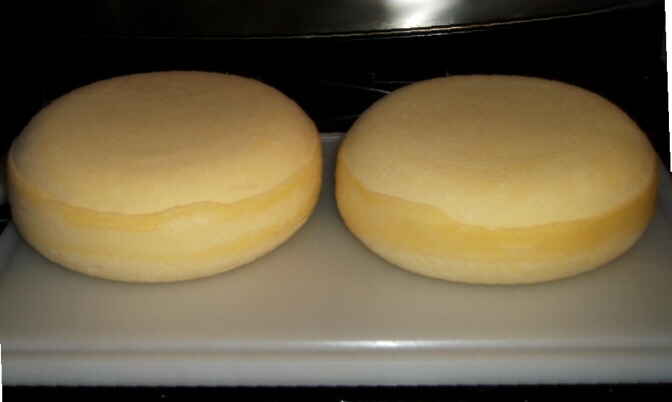Post by deejaydebi on Aug 18, 2009 21:51:46 GMT -5
This one took a bit of research to come up with an authentic recipe idea but I think the results will be worth the effort!

Jarlsberg - Adapted from Danlac/200 cheeses/Study
Ingredients:
7 gallons pasteurized milk
3/4 teaspoon Probat 222
3/4 teaspoon Proprionibacteria 50
1/4 teaspoon sodium nitrate (optional - experimental based on study)
2 teaspoons calcium cloride
1 teaspoon vegetable Rennet
Procedure:
Warm milk to 98°F.
Add cultures and mix well. Let sit for 45 minutes. Target pH: 6.50 + 0.05
Add calcium cloride to 1/4 cup of pure water. Mix well and add to milk.
Add rennet to 1/4 cup of pure water. Mix well - setting time about 15 - 18 minutes. coagulation time: 30 - 40 minutes.
Cut curds to peas size stirring for 30 to 40 minutes.
pH before washing: 6.40 - 6.45. Drain about 30% of the whey. (2.25 gallons)
Add same amount of water as whey removed (30%) at about 140 °F. (2.25 gallons)
Scalding temperature should be about 98 to 108 °F. Scald for 15 - 30 minutes stirring gently.
Add curds to cheesecloth lined molds and press under whey for 10 minutes with 4 pounds of weight.
Increase weight to 8 pounds and press for 15 minutes.
Remove from whey and continue pressing over night.
pH target before brine bath should be 5.40 +/- 0.2
Brine in 1 gallon water and 1 pound of salt for 24 hours at 50°F. (20% brine?)
pH after brine bath: 5.30+/- 0.1
Age at 66°F for 4 weeks.
Package in special foil for large eye formation cheese, or coating
Ripening:
Winter Cool Storage: 47 - 50 °F for 10 - 12 days
Winter warm storage: 64 °F for 4 weeks
Summer Cool Storage: 50 - 57 °F for 7 - 10 days
Summer warm Storage: 68 - 72 °F for 4 - 5 weeks
Mild cheese has been aged 4 to 6 weeks. A Medium cheese has been aged 8 to 12 weeks. Eys will begi to form after about 2 weeks.
Possibilities to enhance eye formation:
higher inoculation amount of propionic acid bacteria type 2
higher scalding temperature up to 104 - 105 °F
shorter salting time with a weaker salt concentration
higher pH after salting: not under pH 5.30 - 5.40
shorter ripening time in cool storage, with a higher temperature, e.g. 7 days at 52 - 57°F
longer ripening time in warm storage, e.g. 5 - 6 weeks at 72 - 75 °F

Jarlsberg - Adapted from Danlac/200 cheeses/Study
Ingredients:
7 gallons pasteurized milk
3/4 teaspoon Probat 222
3/4 teaspoon Proprionibacteria 50
1/4 teaspoon sodium nitrate (optional - experimental based on study)
2 teaspoons calcium cloride
1 teaspoon vegetable Rennet
Procedure:
Warm milk to 98°F.
Add cultures and mix well. Let sit for 45 minutes. Target pH: 6.50 + 0.05
Add calcium cloride to 1/4 cup of pure water. Mix well and add to milk.
Add rennet to 1/4 cup of pure water. Mix well - setting time about 15 - 18 minutes. coagulation time: 30 - 40 minutes.
Cut curds to peas size stirring for 30 to 40 minutes.
pH before washing: 6.40 - 6.45. Drain about 30% of the whey. (2.25 gallons)
Add same amount of water as whey removed (30%) at about 140 °F. (2.25 gallons)
Scalding temperature should be about 98 to 108 °F. Scald for 15 - 30 minutes stirring gently.
Add curds to cheesecloth lined molds and press under whey for 10 minutes with 4 pounds of weight.
Increase weight to 8 pounds and press for 15 minutes.
Remove from whey and continue pressing over night.
pH target before brine bath should be 5.40 +/- 0.2
Brine in 1 gallon water and 1 pound of salt for 24 hours at 50°F. (20% brine?)
pH after brine bath: 5.30+/- 0.1
Age at 66°F for 4 weeks.
Package in special foil for large eye formation cheese, or coating
Ripening:
Winter Cool Storage: 47 - 50 °F for 10 - 12 days
Winter warm storage: 64 °F for 4 weeks
Summer Cool Storage: 50 - 57 °F for 7 - 10 days
Summer warm Storage: 68 - 72 °F for 4 - 5 weeks
Mild cheese has been aged 4 to 6 weeks. A Medium cheese has been aged 8 to 12 weeks. Eys will begi to form after about 2 weeks.
Possibilities to enhance eye formation:
higher inoculation amount of propionic acid bacteria type 2
higher scalding temperature up to 104 - 105 °F
shorter salting time with a weaker salt concentration
higher pH after salting: not under pH 5.30 - 5.40
shorter ripening time in cool storage, with a higher temperature, e.g. 7 days at 52 - 57°F
longer ripening time in warm storage, e.g. 5 - 6 weeks at 72 - 75 °F


 But will make a list and place a order.. What size of pot do you use to hold 7 gal of milk?? And where did you find it?
But will make a list and place a order.. What size of pot do you use to hold 7 gal of milk?? And where did you find it?


